Glossary
If you ever wonderd what’s the meaning of this or that scottish word it is possible, that you can find an answer here
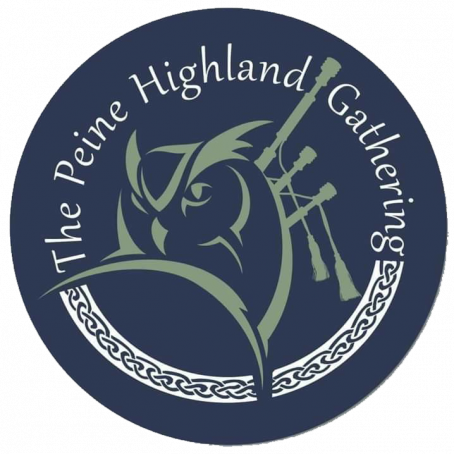
Gathering
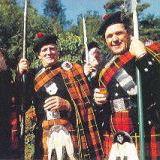
A Gathering could be compared to the marksmen festivals in Germany. In Scottland and everywhere where the spirit of Scottland is held in high esteem, fairs take place during the months of May until September. They originate in events of military tradition. In the eleventh century Malcolm III. gathered his Clans for manoeuvre, where the men competed in peacefull sports. Malcolm III. also introduced the run on the high and steep Craig Choinneach. The winner got a belt, ornated with gold, the baldric.
The most renown Gathering takes place in Braemar, that is regulary visited by the Queen. The biggest Gathering in the world takes place in Cowal. More prominent Highland Gatherings you can find in Oban, Aberdeen, Dunoon, Inverness – to name a few – and of course in Peine!
Haggis
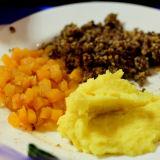
Haggis is an old scottish meal (know the national dish), made from minced sheep’s puck, oatmeal, onions and herbs which are boild in the animals stomach but eaten without. Tradittionally it is served with mashed potatoes an swede (“neeps and tatties”).
Kilt
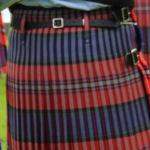
The Kilt is not only a garment, but the attribute most associated as scottish.
A genuine Kilt stretches vom the belly button to the knee, so it won’t touch the ground when kneeling. It is made from a fabric of woven sheeps wool of approx. 8 yards in length. Because it is plaited many times on the rear it is wraped only one and a half times round its bearer. It is held in place by one or more straps on both sides of the hip but usually the bearer also uses a belt with a big, ornamented buckle.
A Kilt is traditionally only worn by men. Women wear kilted skirts of variable length instead.
Beside the full weight Kilt, witch is mainly used for festive events, there are half weight and casual Kilts, Designer-Kilts from other materials or simple Kilts made from woven plasics.
Kilt Pin
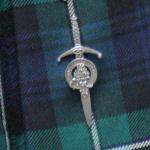
Naturaly the Kilt Pin is a kind of jewellery and its form and style can be used to transport a message. But it’s main purpose is to weight down the end of the Kilt so it won’t flow open during movement or easy wind.
Sgian Dubh
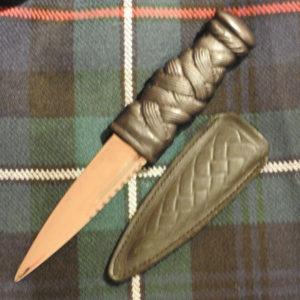
Traditionally it was used a a last possibility of defense, when the bigger dirk was handed over as a sign of respect when enering another’s house. When the English forbade the Scots to carry weapons after the Jacobite risings in the 18. Century the Sgian Dubh was the only weapon that could be hidden from the usual controlls.
Today often it is only a blunt version worn open visible in the kilt hose as a decorational part of the dress. That’s, by the way, the traitional location when among friends. Even if the trust was not so complete to part from it alltogether.
The “black dagger” (also “hidden dagger”) is a short dagger, which handle is usually made from ebony.
Traditionally it was used a a last possibility of defense, when the bigger dirk was handed over as a sign of respect when enering another’s house. When the English forbade the Scots to carry weapons after the Jacobite risings in the 18. Century the Sgian Dubh was the only weapon that could be hidden from the usual controlls.
Today often it is only a blunt version worn open visible in the kilt hose as a decorational part of the dress. That’s, by the way, the traitional location when among friends. Even if the trust was not so complete to part from it alltogether.
Sporran
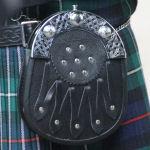
A Kilt has no pockets. That is the reason for a Sporran – a round
bag, usually hung on a chain below the belt buckle. Translatet from old
Scots it means “money pouch”. Normaly the money doesn’t resides there
for long because the landlord doesn’t part from it’s Whisky and Beer for
free ;-)
Sporrans exists in many different varyeties. The everyday Sporran often has only three simple tassles of plain leather. The dress Sporran (often as part of an uniform) is usually richly ornamented, has a trimming of fur or tassels of horse hair.
Ceilidh
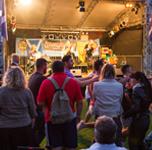
On Saturday evening, a ceilidh will be celebrated at the Peiner Highland Gathering. That means the appearance of a band, a lot of music, dancing and a party mood. Originally the term meant a social gathering of any kind, a party. Today in Ireland and Scotland it is usually understood as a special dance event.

